-
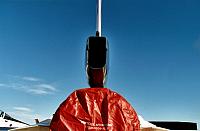
NASA NF-16D detail: Drag chute opening at the rear, note it's empty! [Photo by Daniel PerezVertti]
-
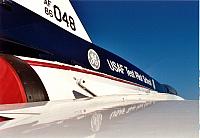
NASA NF-16D detail: Starboard spin chute fitting. [Photo by Daniel PerezVertti]
-
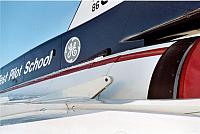
NF-16D detail: Port side spin chute fitting. [Photo by Daniel PerezVertti]
-
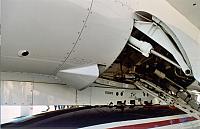
NASA NF-16D detail: Station 5 with centerline drop tank. Note the NF-16D ALWAYS flies with this mounted [Photo by Daniel PerezVertti]
-
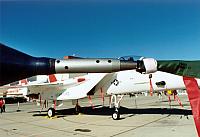
NASA NF-16D detail: Pitot tube closeup. [Photo by Daniel PerezVertti]
-
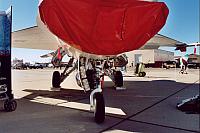
NASA NF-16D detail: intake, nose gear and landing/taxi lights. [Photo by Daniel PerezVertti]
-
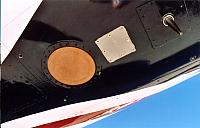
NASA NF-16D detail: Radar altimeter and added yaw probe. [Photo by Daniel PerezVertti]
-
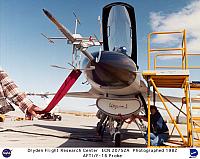
Detailled view of the F-16/AFTI test probe [NASA photo]
-
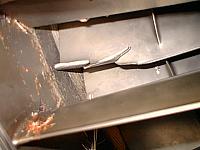
Inlet bird strike [Photo by Jeff]
-
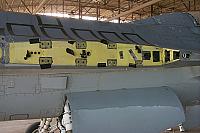
Wing attach area of an AMARC stored F-16B [USAF photo]
-
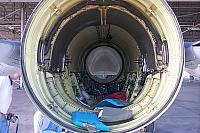
Empty engine bay of an AMARC stored viper [USAF photo]
-
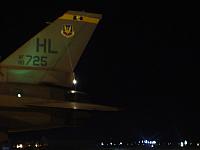
You can clearly see the tail light on this viper (#90725) It has a green shadow, meaning this aircraft has the ability to fly with NVG. [Photo by Jetmech]
-
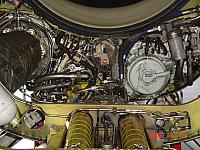
This is a block 40 engine bay with the panels completely removed. The tight design of all components is obvious [Photo by Jetmech]
-
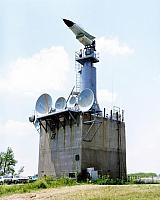
Prior to the arrival of a full F-16 aircraft, an F-16 nose section is mounted on a testing tower at the Rome ADC Newport Site, Tanner Hill on March 11th, 1980. At this facility portions of an aircraft can be tested to determine what effect they have on transmitting and receiving electromagnetic signals. [USAF photo]
-
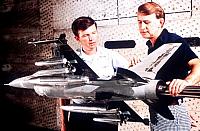
Technicians discuss an F-16 aircraft model in a test wind tunnel at the Engineering Development Center on January 1st, 1981. The model holds an assortment of armament models. [Photo by AFSC]
 NASA NF-16D detail: Drag chute opening at the rear, note it's empty! [Photo by Daniel PerezVertti]
NASA NF-16D detail: Drag chute opening at the rear, note it's empty! [Photo by Daniel PerezVertti] NASA NF-16D detail: Starboard spin chute fitting. [Photo by Daniel PerezVertti]
NASA NF-16D detail: Starboard spin chute fitting. [Photo by Daniel PerezVertti] NF-16D detail: Port side spin chute fitting. [Photo by Daniel PerezVertti]
NF-16D detail: Port side spin chute fitting. [Photo by Daniel PerezVertti] NASA NF-16D detail: Station 5 with centerline drop tank. Note the NF-16D ALWAYS flies with this mounted [Photo by Daniel PerezVertti]
NASA NF-16D detail: Station 5 with centerline drop tank. Note the NF-16D ALWAYS flies with this mounted [Photo by Daniel PerezVertti] NASA NF-16D detail: Pitot tube closeup. [Photo by Daniel PerezVertti]
NASA NF-16D detail: Pitot tube closeup. [Photo by Daniel PerezVertti] NASA NF-16D detail: intake, nose gear and landing/taxi lights. [Photo by Daniel PerezVertti]
NASA NF-16D detail: intake, nose gear and landing/taxi lights. [Photo by Daniel PerezVertti] NASA NF-16D detail: Radar altimeter and added yaw probe. [Photo by Daniel PerezVertti]
NASA NF-16D detail: Radar altimeter and added yaw probe. [Photo by Daniel PerezVertti] Detailled view of the F-16/AFTI test probe [NASA photo]
Detailled view of the F-16/AFTI test probe [NASA photo] Inlet bird strike [Photo by Jeff]
Inlet bird strike [Photo by Jeff] Wing attach area of an AMARC stored F-16B [USAF photo]
Wing attach area of an AMARC stored F-16B [USAF photo] Empty engine bay of an AMARC stored viper [USAF photo]
Empty engine bay of an AMARC stored viper [USAF photo] You can clearly see the tail light on this viper (#90725) It has a green shadow, meaning this aircraft has the ability to fly with NVG. [Photo by Jetmech]
You can clearly see the tail light on this viper (#90725) It has a green shadow, meaning this aircraft has the ability to fly with NVG. [Photo by Jetmech] This is a block 40 engine bay with the panels completely removed. The tight design of all components is obvious [Photo by Jetmech]
This is a block 40 engine bay with the panels completely removed. The tight design of all components is obvious [Photo by Jetmech] Prior to the arrival of a full F-16 aircraft, an F-16 nose section is mounted on a testing tower at the Rome ADC Newport Site, Tanner Hill on March 11th, 1980. At this facility portions of an aircraft can be tested to determine what effect they have on transmitting and receiving electromagnetic signals. [USAF photo]
Prior to the arrival of a full F-16 aircraft, an F-16 nose section is mounted on a testing tower at the Rome ADC Newport Site, Tanner Hill on March 11th, 1980. At this facility portions of an aircraft can be tested to determine what effect they have on transmitting and receiving electromagnetic signals. [USAF photo] Technicians discuss an F-16 aircraft model in a test wind tunnel at the Engineering Development Center on January 1st, 1981. The model holds an assortment of armament models. [Photo by AFSC]
Technicians discuss an F-16 aircraft model in a test wind tunnel at the Engineering Development Center on January 1st, 1981. The model holds an assortment of armament models. [Photo by AFSC]